Pond’s Extract Company
Pond’s started out in 1846 as a patent medicine company when Theron T. Pond [1880-1852], a pharmacist from Utica, New York, began selling ‘Golden Treasure’, a homeopathic remedy containing witch hazel. In 1849, Theron Pond, Alexander Hart and Edmund Munson formed the T. T. Pond Company to make and sell Golden Treasure renamed as Pond’s Extract. After the American Civil War [1861-1865] soap and toiletries were added to the product list. Changes of ownership, Theron Pond’s death, and legal disputes over who owned the manufacturing rights to the extract, created problems for the early Pond’s, but, by the 1880s, things had settled down and the Pond’s Extract Company emerged.
Pond’s Extract
Pond’s Extract was a simple mixture of witch hazel distillate, taken from the shrub Hamamelis virginica, preserved in alcohol. It was promoted as a general cure-all for a wide variety of ailments including: burns, colds, catarrh, wounds, chilblains, hoarseness, sore throats, piles, scalds, bruises, sunburn, rheumatism, chapped hands, bites, boils, chafing, lameness, nosebleed, frost bite, inflamed eyes and female complaints. By the twentieth century most of these patent medicine claims had been dropped and the product was then promoted as a general antiseptic for bites, wounds, sunburn and for use after shaving. Advertising was often aimed at families, presumably because children were expected to have more scrapes.
Pond’s Extract, first produced in 1846. Most of us remember how tenderly our mothers touched our childish wounds with this healing soothing lotion. Today any physician will tell you it is still the best of household remedies. Get a bottle today, you will be surprised at how frequently you use it.
(Pond’s advertisement, 1916)
Witch hazel’s effectiveness as an antiseptic was disputed. In 1886, a laboratory investigation suggested that its virtues were due more to the alcohol in the product than anything else. In 1916, this view was endorsed by the National Dispensatory which stated that “The good that it exerts in the treatment of sprains, bruises, wounds, chilblains, sore eyes, headache, and a host of other conditions, resides more in the activity of a cleansing and evaporating lotion and in the mind of its user, than in any decided curative properties that the preparation may possess.” (Lloyd & Lloyd, 1935).
In the 1880s, several new witch hazel based preparations were added to the company’s product line including: an ointment, a dentifrice, plasters, a toilet cream, a soap, a lip salve, a catarrh cure, and medicated papers. Unfortunately, the products simplicity meant that it was easily copied and many customers simply bought something that was cheaper and Pond’s advertising did little to persuade customers to do otherwise.
Recognising the problem, Pond’s hired W.T. Seagrave as its new advertising manager in 1905. Seagrave dramatically increased Pond’s advertising budget, allocating a good deal of it to newspapers. He tripled the sales of Pond’s products within a year and took over the management of Pond’s from Thomas Lawson in 1906.
Lamont, Corliss & Company
The improved sales at Pond’s seems to have caught the attention of Lamont, Corliss, a New York firm established in 1901 by Thomas William Lamont [1870-1948] and his brother-in-law Charles Albert Corliss [1868-1936]. In 1906, Lamont, Corliss took control of Pond’s just after Seagrave became its new manager causing Seagrave to resign. Charles Corliss became the president of Pond’s, Clifford Myron Baker [1883-1979] another Lamont, Corliss man, became a vice-president and general manager and Lamont, Corliss took over the marketing and distribution of Pond’s products.
Two creams
In the face of increased competition for witch hazel products, Pond’s had begun looking at alternative products well before it was taken over by Lamont, Corliss. A marketing survey it had commissioned in 1891 identified an increased demand for skin-care products (Peiss, 2007, p. 99) the company began adding these to its range. In 1904, Pond’s introduced Pond’s Extract Vanishing Cream developed by a Pond’s chemist, William T. Wallbridge and followed this with Pond’s Extract Cold Cream in 1905. Both creams were sold in opal jars for the home and in tubes for the handbag.
Pond’s Cold Cream: “[A]n oil cream. It is scientifically prepared from ingredients chosen for their cleansing, lubricating qualities. It is wonderfully dewy and smooth—has just the quality for proper massaging and for removing dust and grime without irritation.”
Pond’s Vanishing Cream: “[C]ontains no oil and is not intended for cleansing or for massage. The base is a wonderful skin-softening ingredient which has a special affinity for the skin—an ingredient recognised by dermatologists the world over as one of the utmost value to the skin.”
Pond’s Extract Vanishing Cream was a stearate emulsion using glycerine as a humectant. Pond’s was not the first company to make a cream of this type. That credit goes to Burroughs Wellcome’s Hazeline Snow, introduced in 1892. However, it seems very likely that Pond’s was the first company to call a stearate cream ‘vanishing’, a term that it became synonymous with creams of this type.
See also: Hazeline Snow and Vanishing Creams
Pond’s Extract Cold Cream was a typical beeswax-borax emulsion made with mineral oil. However, rather than being a new development, it is possible that Pond’s simply renamed an existing product.
In 1904, the year the company introduced Pond’s Extract Vanishing Cream, Pond’s had two other creams in their inventory – Pond’s Extract Cream and Pond’s Extract Antiseptic Cream. The Antiseptic Cream was claimed to have antiseptic and analgesic (pain-subduing) properties and contained “constituents of of mentha piperita and an oxidized terpene obtained from an East Indian plant” (Harriet Hubbard Ayer, 1904). Pond’s Extract Cream was described as a cleanser, skin food and skin tonic but was also recommended as a massage cream.
After a day in the sun, wind or dust, it will be found that anointing the face and neck with this wonderful massage cream has a wonderful effect, not only in removing the dust and foreign substances from the surface, but in feeding the tissues, healing the dry and stretched cuticle and restoring the skinn to its natural resiliency.
The cream bath should in such cases procede washing the face. Wrap a bit of soft, old linen around the fingers and dip into the cream, and freely apply all over the face, neck and arms if necessary. The cream will remove the dust and heal the tired, exhausted skin, and the oils not absorbed may be removed by bathing with soap and warm water two or three hours later.(Harriet Hubbard Ayer, 1904)
Like Pond’s Extract Cream, Pond’s Extract Cold Cream also originally contained witch hazel and its appearance coincides with the disappearance of the Extract Cream from Pond’s advertising. Although not conclusive, this suggest that Pond’s Extract Cold Cream was a renamed Pond’s Extract Cream.
See also: Cold Creams and the booklet Beauty (1904).
Introducing these two creams to potential customers was not without its problems as J. K. L. Wenham, Managing Director of Pond’s Extract described in 1950.
To introduce our creams we used demonstration jars of cream. These were sent to all our clients for counter use. And to be hygienic we supplied a small silver spoon, to prevent dirty fingers from being pushed into the cream. But you eat with spoons and so the cream soon vanished from the jars. The only complaints we received were not about texture—but about taste. It never occurred to the public to try it on the skin. That was our first mistake, and the second was supplying a silver spoon. The chemist was frequently asking for more.
The education of the public to use creams was a slow process, with only press advertising as the instructor.(Manufacturing Perfumer, 1950)
At first the creams were given very little publicity and were only mentioned in small print at the bottom of larger advertisements for Pond’s Extract but, by the beginning of the First World War, the situation had reversed. Sales really took off when the products were promoted together. A marketing campaign developed by the J. Walter Thompson advertising company in 1916, based on the idea that ‘Every skin needs two creams’, resulted in a threefold increase in sales by 1920 (Peiss, 1998, p. 121).
Every normal skin requires two creams. A cold or grease cream for cleansing, for massages, and a non-oily, greaseless cream before going out—to protect the skin from chapping, to keep it from becoming dry and tough.
No matter what creams you are using now, send for the free samples of these two creams. Rub the cold cream on one hand, the vanishing cream on the other. See how different each cream is—how each cream, in its own way, benefits your skin.(Pond’s advertisement, 1917)
The marketing campaign promoted the use of each cream as part of a skin-care system – the cold cream as a cleanser, and for massaging the skin at night, the vanishing cream as a skin protectant during the day. Advertising stressed the need for both creams and gave detailed instructions on how they were to be used. For many women this was the first time they had a simple skin-care routine they could follow.

Above: 1928 Pond’s Three Steps to Beauty (Britain).
In 1923, to help identify each cream, the company added prominent capitals to the packaging with a large ‘C’ for cold cream and a ‘V’ for vanishing cream. Pond’s continued to advertise the two creams together until 1934 when separate advertising was reintroduced.
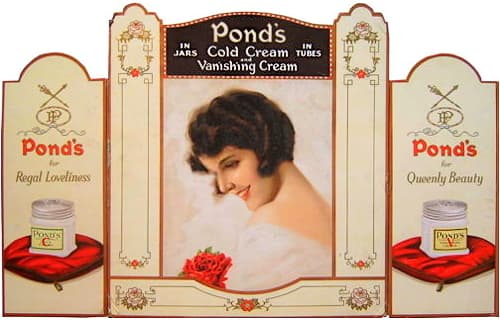
Above: c.1923 Pond’s counter display showing new packaging.
Testimonials
As the skin-care business became more competitive in the 1920s, Pond’s began to lose sales to higher-priced lines from salon-based companies like Elizabeth Arden and Helena Rubinstein. As one market researcher noted, “women thought that higher priced creams must be better” (Peiss, 2007, p. 137).
Pond’s tried to counteract this trend with an extensive advertising campaign based on testimonials. Pond’s had used stage personalities for endorsements in the past, but the new campaign, begun in 1924, attempted to give Pond’s creams more cachet by having them endorsed by socialites and members of the European aristocracy. Although it improved sales the campaign came at a cost, with Pond’s spending nearly US$60,000 in advertising in the U.S. in one month of 1926, almost three times that of Elizabeth Arden (Peiss, 2007, p. 106). I doubt that anyone was convinced that either the cold or vanishing creams had become upscale, high-class cosmetics, but the testimonials must have had some effect as the company persisted with them. Pond’s continued to use testimonials through the ‘She’s Engaged, She’s Lovely, She uses Pond’s’ campaign of the 1940s and beyond, although the endorsements came from younger, better-looking women.
Pond’s also responded to the increasing sophistication of its customers by adding Pond’s Skin Freshener and Pond’s Cleansing Tissues in 1927.
Pond’s Cleansing Tissues: “[S]ilky soft. Modern science prescribes them for removing cold cream. They are generously large and firm, and so marvelously absorbent that in an instant they wipe away dirt and oil.”
Pond’s Skin Freshener: “It is a tonic and mild astringent safe to use as often as you need. It closes the pores and tones and firms your skin—brings lovely glowing youth to your cheeks.”
The new Pond’s skin-care routine that incorporated these new products now became a four-step process. In reality, it was very similar to other 1920’s three-step skin-care routines.

Above: 1929 Pond’s Skin-Care System (Britain).
Manufacturing
After beginning in Utrica, New York, Pond’s moved to Chester, Connecticut in the 1870s. When a fire destroyed the Chester plant the company relocated to John Street in Clinton, Connecticut in 1888 adding additioanl manufacturing capacity between 1895 and 1901.
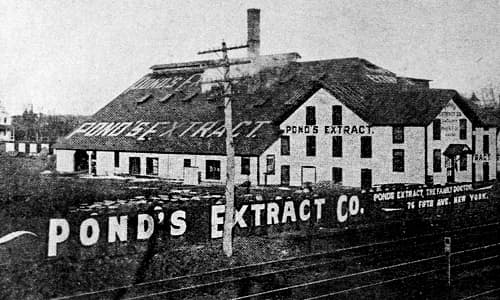
Above: 1905 Pond’s factory in Clinton, Connecticut conveniently located on a railway line.
By the late 1920s the factory was running out of space and a new Art Deco inspired building was constructed in 1929. It still stands today.
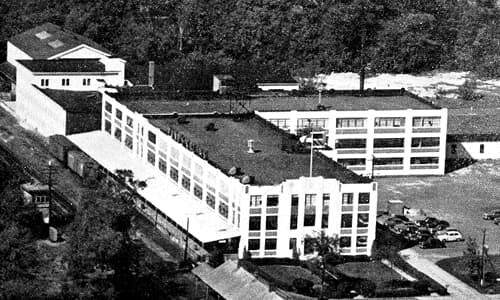
Above: 1935 Pond’s factory in Clinton, Connecticut.
Overseas Expansion
Pond’s had opened a London branch by 1878 and moved into other overseas countries after that. Pond’s Extract Vanishing Cream was introduced into Britain in 1905 followed by Pond’s Extract Cold Cream in 1906 with both products being sold in Europe from 1915. Many women switched to budget-priced creams during the Great Depression so the 1930s was marked by further expansion.
In 1932, the company opened a factory in Perivale, London and also began subcontracting the manufacture of its products elsewhere to increase its global reach. By the end of the 1930s, Pond’s products were being sold in 96 countries around the world with overseas sales making up 40% of its revenues (Jones, 2010, p. 128).
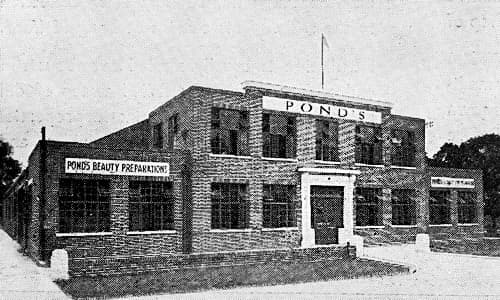
Above: 1932 Pond’s factory in Perivale, London.
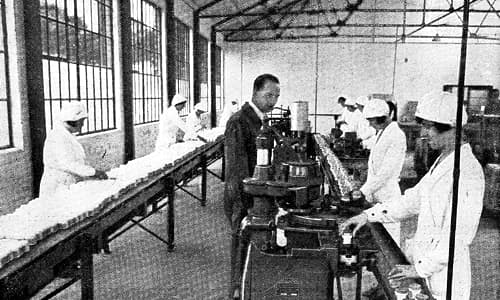
Above: 1932 Manufacturing Pond’s creams at the Perivale factory.
Adjusting to change
In 1933, in an attempt to get around some of the perceived problems with its cold cream, Pond’s introduced Pond’s Liquefying Cream as an alternative cleanser. The product was given a prominent ‘L’ on the label and was often advertised as a quick cleanser.
Pond’s Liquefying Cream: “A quicker-melting cream. Fine for quick cleansings.”
See also: Liquefying Cleansing Creams
Pond’s also tried to rebadged its cold cream as being more than a cleanser. In its ‘Under Skin’ campaign it suggested that as the oils penetrated deep into the skin it would improve blackheads, lines, coarse pores and dry skin.
If pores were windows, you could look deep into your underskin and see! Overactive glands loading up your pores, stretching them wide. Underactive glands parching your skin, drying it up. Tiny fibres losing tension—letting ugly lines form outside!
Skin becomes Smooth, Line-free … Most skin faults start the same way—under your skin. Even the very blemishes and blackheads that spoil a young girl’s looks! But you can invigourate those failing glands and cells and fibres ’rouse them to a fresh start—see you skin faultless! Pond’s Deep-skin Cream is made for this purpose.
The specially processed oils of Pond’s Cold Cream go way down deep—releasing all the dried-up dirt, make-up, secretions, wedged in your pores. Even the first time you use Pond’s, you’ll see your skin clearer, fresher, smoother by far.(Pond’s advertisement, 1936)
Pond’s would continue to promote its cold cream as a dry skin remedy but, seeing the way the wind was blowing, introduced Pond’s Dry Skin Cream containing lanolin in 1941.
Pond’s Dry Skin Cream: “Exceptionally rich and deep penetrating. Pond’s Dry Skin Cream goes right to work on dry skin problems that “middle-age” a woman’s face.”
Skin vitamins
Although claims made for Pond’s skin-care products were generally restrained they did occasionally succumb to the ‘magic ingredient’ addition, as for example, when they included a ‘skin-vitamin’ to their creams in 1937.
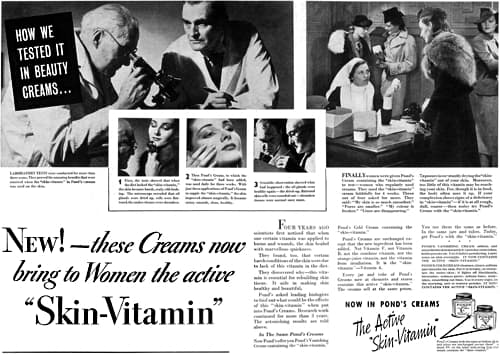
1938 Pond’s Skin-Vitamin.
A new type of cream is bringing more direct help to women’s skin!
It is bringing to their aid the vitamin which essentially helps build new skin tissue, the vitamin which helps to keep the skin healthy and glowing—the “skin-vitamin.”
When there is not enough of this “skin-vitamin” in the diet, the skin may suffer—become undernourished, rough and subject to infections. Skin faults would result.
For over three years Pond’s tested this “skin-vitamin.” in Pond’s Creams.
… When women used the creams, three out of every four of them came back asking for more. In four weeks they reported pores looking finer, skin smoother, richer looking!
Every jar of Pond’s Cold Cream now contains the precious “skin-vitamin.” Not the “sunshine” vitamin. Not the orange juice vitamin. Not “irradiated.” But the vitamin which especially helps rebuild skin tissue.(Pond’s advertisement, 1937)
The unnamed ‘skin-vitamin’ was vitamin A. Tests indicated that it was added, along with a very small amount of vitamin D, to the company’s Liquefying Cream, Cold Cream, Vanishing Cream and Danya Lotion: a small ‘SV’ on the label indicating they were there. Unfortunately for Pond’s, the United States passed the Food, Drugs and Cosmetics Act in 1938, and, in 1941, it was ordered to cease and desist misrepresenting the benefits of vitamins in its products (JAMA, 1942). It seems Pond’s knew this was coming as advertising that highlighted the ‘skin-vitamin’ was discontinued after 1939.
See also: Vitamin Creams
Sales of vanishing creams declined in the second half of 1930s, including those produced by Pond’s. Perhaps because of this the company introduced the 1-Minute Mask campaign in 1941. This involved applying a thick layer of Pond’s Vanishing Cream on the face and leaving it there for at least one minute to act as a mask. The hope was that this would bolster sales.
NEW 1-Minute Mask of Pond’s Vanishing Cream releases coarsening surface scuff. Its “keratolytic” action dissolves and loosens dried skin and dirt particles. Smooth mask thick over face and throat (except eyes).
AFTER a full minute simply wipe off Mask! See how much lovelier your skin is! So much softer feeling. So much Fresher, clearer looking!(Pond’s advertisement, 1941)
However, as the newer cake make-up, liquid and powder-creams did not need to use vanishing cream as a powder base, and speciality creams promised better skin protection, the use of vanishing creams, like those made by Pond’s, continued to decline.
Hand preparations
In the 1930s, Pond’s introduced a series of hand creams starting with Pond’s Hand Lotion and Pond’s Danya Cream Lotion (1937) followed by Pond’s Angel Skin (1953). Danya Cream Lotion featured in the ‘She’s Engaged, She’s Lovely, She uses Pond’s’ campaign begun in 1942 which often contained a hand displaying an engagement ring. Sales were disappointing and it was discontinued in 1943. Advertising for Angel Skin was aimed firmly at the housewife with ‘detergent hands’ and sales were a lot better.
Pond’s Hand Lotion: “[C]onstant plunging in hot water, house and office work, gardening, sports, exposure to wind and sun all combine to dry the natural moisture from skin. You can renew the youth and beauty of your hands by renewing this natural moisture.”
Pond’s Lotion (Danya): “Don’t let work rob your hands of their feminine charm. Thousands of women today have found a way to take care of a house, children—or to work a job every day—and still keep their hands soft and smooth.”
Pond’s Angel Skin: “Remarkably unlike other lotions—Angel Skin neutralizes the drying, chemical action of detergents and soaps … helps prevent irritation! Housewives report amazing improvements in their hands after using Angel Skin.”
Make-up
Pond’s had sold face and body powders before the First World War but neither product was promoted with any degree of fervour. Things began to change in 1932 when the company launched Pond’s Powder in five shades. In 1941, this was followed by the introduction of the Dreamflower Powder with Dreamflower Dusting and Talcum Powders added later.
Pond’s Face Powder: “[A]dds a smooth-as-baby-skin finish and keeps away shine for hours!” Shades: Naturelle, Light Cream, Brunette, Rose Cream, Rose Brunette, Dark Brunette. Later shades: Light Natural, and Rose Dawn.
Pond’s Dreamflower Powder: “[T]o mist your face with soft enchantment … to give you a ‘dream girl’ complexion … and keep it that way.” Shades: Natural, Rose Cream, Rachel, Brunette, Dusk Rose, and Dark Rachel with Mocha, Camellia, and Peach added later.
Sometime during the 1930s the company added an indelible lipstick and compact rouge in matching shades. The lipstick was initially produced in five shades, with new ‘enticing Stagline Shades’ added in 1940s that included: Honey, Rascal Red, Dark Secret, Heart Beat, Natural, Beau Bait, Black Blaze, Dither, Heart Throb, and Blue Fire. It is hard not to judge the names and the reference to ‘Stagline’ as being a little obvious. The lipstick and rouge were rebadged in the 1940s as Pond’s Lips and Pond’s Cheeks respectively.
Pond’s Lips lipstick: “[B]lended scientifically to keep their warm, rich tones in the broad sunlight or under the glare of electric lights … as alluring by day as by night.” Shades: Honey, Rascal Red, Dark Secret, Heart Beat, and Natural. Later shades: Beau Bait, Black Blaze, Dither, Heart Throb, and Blue Fire.
Pond’s Cheeks rouge: “[B]lend a little … up around the cheekbones and over the eyes—very youthifying, the ‘reflected glow’ of rouge used this way.” Shades: Same as Lips lipsticks.
War
Pond’s made an number of contributions to the war effort including the manufacture of prisoner of war packages for the Red Cross and K-rations for the armed services. The company also made over 6 million tubes of camouflage cream for the army and between 30 and 50 million bottles of insect repellant (New Haven Register, 1978).
Alcohol shortages during the war force the company to cease production of the original Pond’s Extract and although the distilling vats were recommissioned after the war they were shut down permanently in 1950. However, some new products were introduced. Following the success of Max Factor’s Pan-Cake make-up, released for general use in 1938, Pond’s produced its own version in 1943, under the name Make-Up Pat. Like other cake make-ups it was applied with a moist sponge then blended with the fingertips before being finished off with powder.
Pond’s Make-up Pat: “Easy way to a smooth, flawless looking complexion. Exquisite glowing shades. Stays on!” Shades: Rose Cream, Dark Rachel, Rachel, Dusk Rose, Natural, and Brunette.
See also: Cake Make-up
Post war
There were few developments in Pond’s skin-care range in the period between 1945 and the company’s union with Chesebrough in 1955 but a number of new make-up items were introduced.
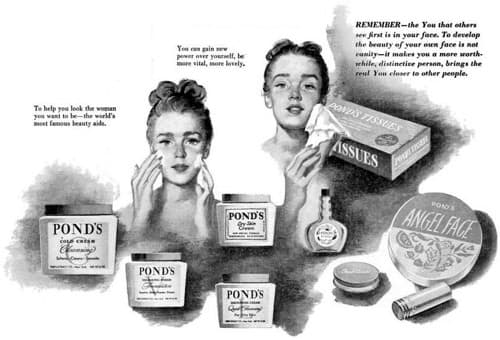
1947 Pond’s Cold Cream, Vanishing Cream, Dry Skin Cream, Liquefying Cream, Tissues, Freshener, Cheeks rouge, Angel Face powder-cream and Lips lipstick.
In 1946, Pond’s introduced their Angel Face compact powder in five shades. As a powder-cream it was applied with a puff rather than with the wet sponge needed for cake make-up. A mirror case model, introduced in 1950, later completed the package and sold well.
Pond’s Angel Face: “A sensational new make-up that’s easier to apply—no water, no greasy fingertips. And it stays on longer than powder! A smoothing ‘cling’ ingredient is pressure-fused into Angel Face. Makes it go on evenly—stay on.” Shades: Blonde Angel, Ivory Angel, Pink Angel, Tawny Angel, Bronze Angel, Blushing Angel, Gypsy, and Golden Angel.
The company leveraged the success of Angel Face and began the process of turning it into a complete range introducing Angel Skin (1953) and Angel Lips (1954). The Angel Face range was extended further after Pond’s merged with Chesebrough in 1955.
In 1952, added Make-up Mist, a liquid foundation in five shades packaged in a handy squeeze bottle. It does not appear to have been a success.
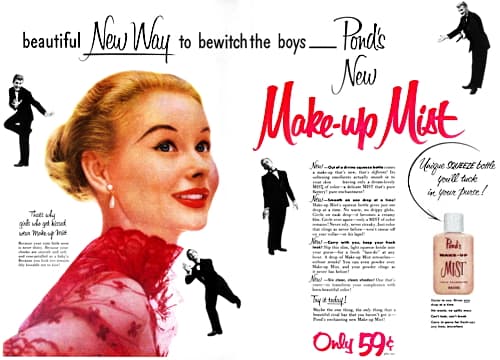
1954 Pond’s Make-up Mist.
Make-up Mist: “[M]akes you look sensational, but still look like you’re wearing your own face! That’s because it blends so smoothly, so perfectly you can’t see where it begins and ends! You can even re-touch over it without leaving streaks.”
Chesebrough-Pond’s
Lamont, Corliss also had a major interest in chocolates, particularly in the Peter Cailler Kohler Swiss Chocolate Company. When Unlilac, Inc., owned by the Swiss company Nestlé, bought a controlling intererst in Lamont, Corliss in 1949 to gain control of these American chocolate interests it became necessary to separate them from Pond’s, a business Nestlé had no interest in. This required Pond’s Extract to set up its own sales force and distribution system in 1950.
By the time Pond’s separated from the rest of Lamont, Corliss it was firmly situated in the middle to lower end of the cosmetic market. One way to survive in this market was to be large and this may have been why Pond’s Extract combined with the Chesebrough Manufacturing Company, Consolidated – the makers of Vaseline – in 1955. The two companies were not strangers. In 1948, Clifford Baker while chairman of the board of Pond’s and a vice-president of Lamont, Corliss, had became a director at Chesebrough.
The combination of Pond’s and Chesebrough was a good match and the new company, Chesebrough-Pond’s, would go on to become stronger than its individual component parts.
See also: Chesebrough Manufacturing Company and Chesebrough-Pond’s
Timeline
| 1846 | Theron T. Pond produces a witch hazel extract initially sold as Golden Treasure. |
| 1852 | Theron T. Pond dies. |
| 1872 | Pond’s Extract Company formed in New York. |
| 1876 | Pond’s Extract trademarks registered in Britain. |
| 1878 | Pond’s Extract opens a branch in London. |
| 1882 | New products are developed including a toilet cream, dentifrice, lip salve, ointment, porous plasters, catarrh remedy and toilet soap. |
| 1886 | Pond’s launches its first national advertising campaign in America. |
| 1888 | Manufacturing relocates to Clinton, Connecticut. |
| 1904 | New Products: Pond’s Extract Vanishing Cream. |
| 1905 | New Products: Pond’s Extract Cold Cream. |
| 1906 | Lamont, Corliss takes control of Pond’s. |
| 1914 | Pond’s incorporates. |
| 1915 | Pond’s Extract Cold Cream and Pond’s Extract Vanishing Cream introduced into Europe. |
| 1916 | ‘Every skin needs two creams’ advertising campaign begun. |
| 1923 | Pond’s registers C (cold cream) and V (vanishing cream). |
| 1924 | Testimonial advertising campaign begins. |
| 1927 | Factory opened in Canada. New Products: Pond’s Skin Freshener & Tonic; and Pond’s Cleansing Tissues. |
| 1932 | Factory opened in Perivale, London. New Products: Pond’s Face Powder. |
| 1934 | New York headquarters moved to the Western Union Building at 60 Hudson Street. New Products: Pond’s Liquefying Cream. |
| 1937 | Pond’s begins sponsoring radio programs (U.S.). Pond’s adds vitamins to its cosmetics. New Products: Danya, a hand cream. |
| 1940 | New Products: Pond’s Lips lipsticks. |
| 1941 | New Products: Pond’s Dry Skin Cream and Dreamflower Face Powder. |
| 1942 | New Products: Pond’s Cheeks compact rouge. |
| 1943 | Danya discontinued because of disappointing sales. New Products: Make-Up Pat, a cake foundation. |
| 1946 | New Products: Angel Face Compact Powder (mirror case compact added in 1950); Dreamflower Talc; and Dreamflower Dusting Powder. |
| 1950 | Pond’s stops distributing its products through Lamont, Corliss & Company and sets up its own sales force. |
| 1951 | Pond’s sponsors its first television show. |
| 1952 | New Products: Pond’s Make-up Mist. |
| 1953 | New Products: Angel Skin Hand Cream. |
| 1954 | New Products: Angel Lips. |
| 1955 | Pond’s and the Chesebrough Manufacturing Company combine to form Chesebrough-Pond’s. |
First Posted: 14th November 2011
Last Update: 6th April 2022
Sources
Jones, G. (2010). Beauty imagined: A history of the global beauty industry. Oxford: Oxford University Press.
Journal of the American medical association. (1942). Chicago: Author.
Lloyd, J. U., & Lloyd, J. T. (1935). History of Hamamelis (witch hazel) extract and distillate. Journal of the American Pharmaceutical Association. 24(3).
New advertising energy for Pond’s extract. (1906). Printers’ Ink. 54(1), 15-17.
Peiss, K. (2007). Hope in a jar: The making of America’s beauty culture. New York: Henry Holt and Company.
Sutton, D. H. (2009). Globalizing ideal beauty. How female copywriters of the J. Walter Thompson advertising agency redefined beauty for the twentieth century. New York: Palgrave Macmillan.
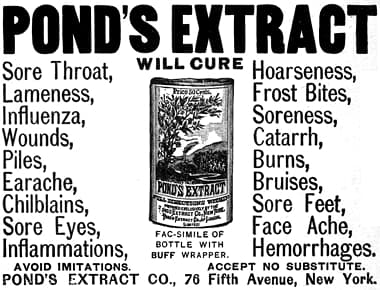
1894 Pond’s Extract.
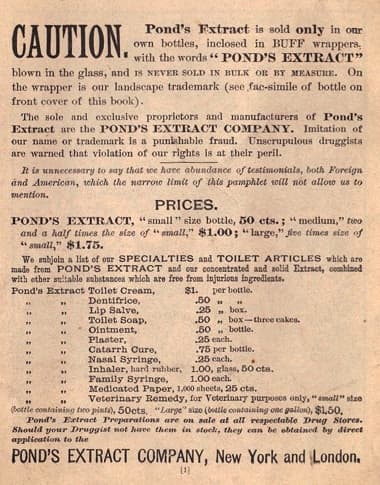
Part of a brochure for the Pond’s Extract Company showing products made.
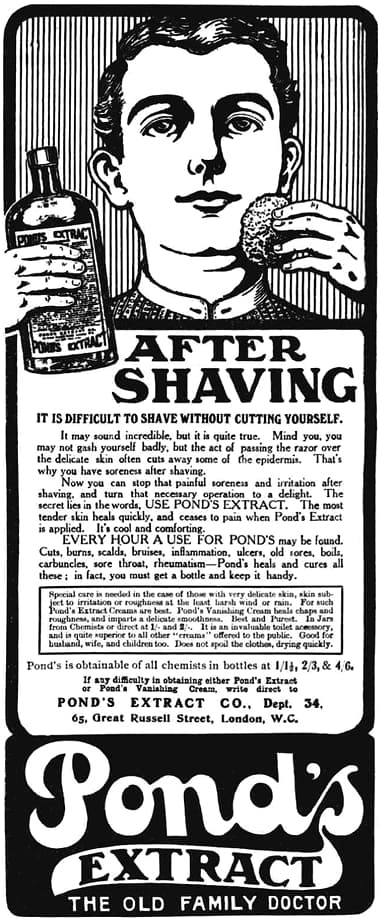
1908 Pond’s Extract after shaving.
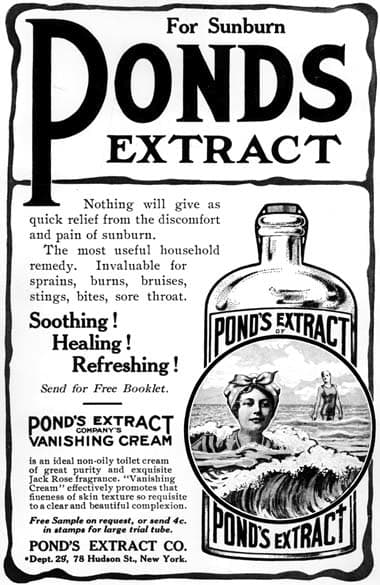
1911 Pond’s Extract and Pond’s Vanishing Cream.

Four products from a Pond’s brochure titled ‘Creams for the Skin’ probably dated 1916. The products mentioned are Pond’s Extract Face Powder, Talcum Powder, Complexion Soap and Toothpaste.
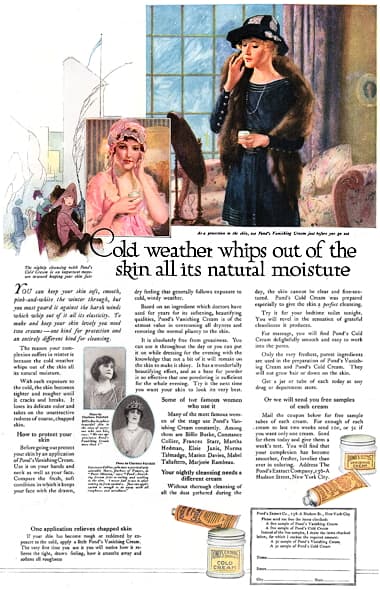
1919 Pond’s Cold Cream and Pond’s Vanishing Cream.

1924 Pond’s Cold Cream (Britain).
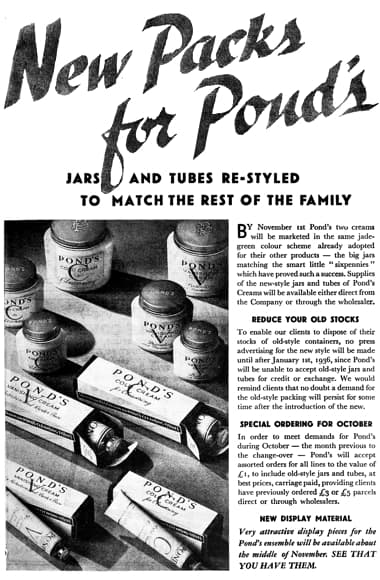
1925 Pond’s in new packaging.

1925 Pond’s Two Creams.
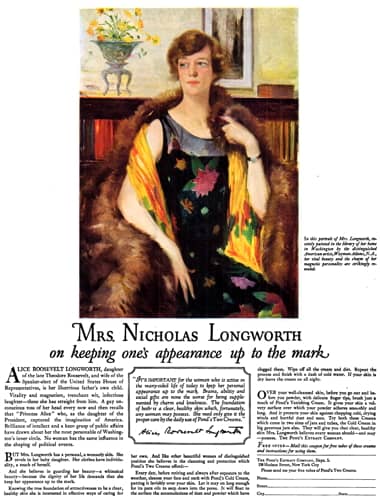
1925 Pond’s testimonial advertisement.
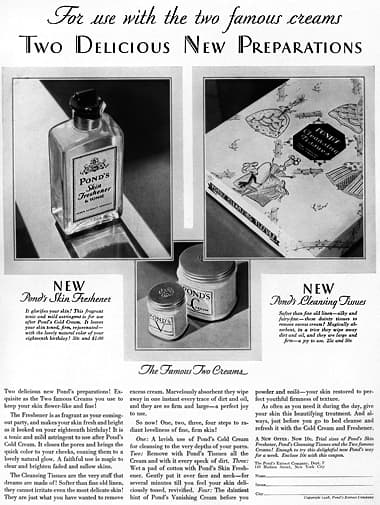
1928 Pond’s Skin Tissues and Skin Freshener.
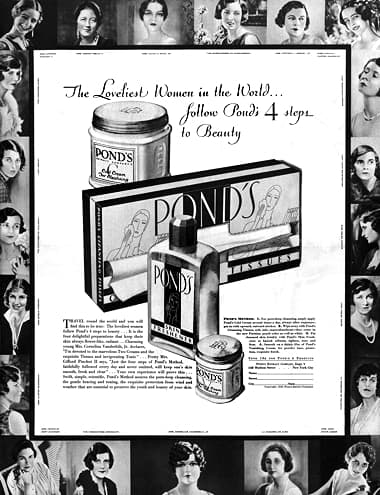
1930 Pond’s 4 Steps to Beauty requiring Cold Cream, Cleansing Tissues, Skin Freshener and Vanishing Cream.
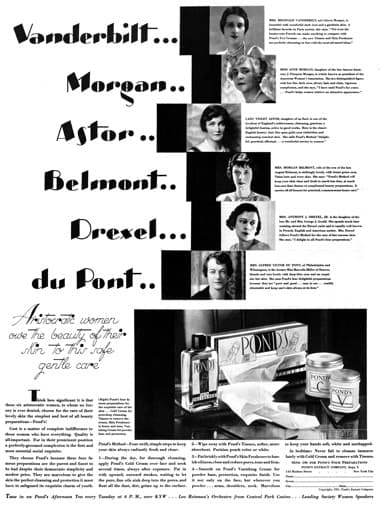
1931 Pond’s testimonials.
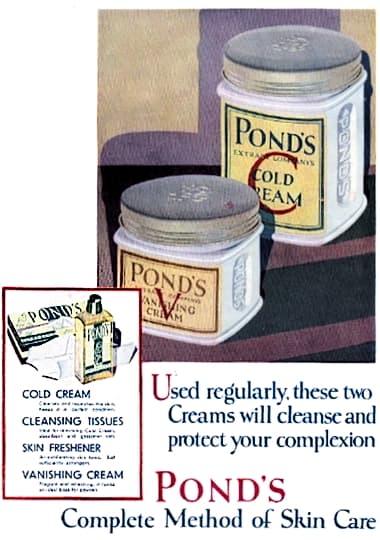
1931 Pond’s Cold Cream, Skin Tissues, Skin Freshener and Vanishing Cream.
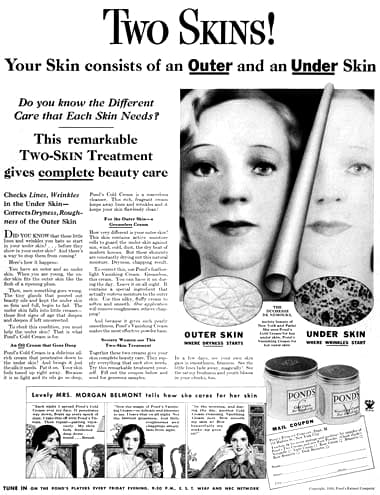
1933 Pond’s Cold and Vanishing Creams.
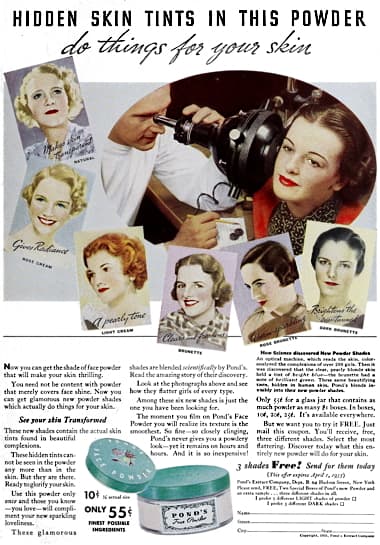
1935 Pond’s Face Powder.

1935 Pond’s Cold Cream for lines, wrinkles and blemishes.
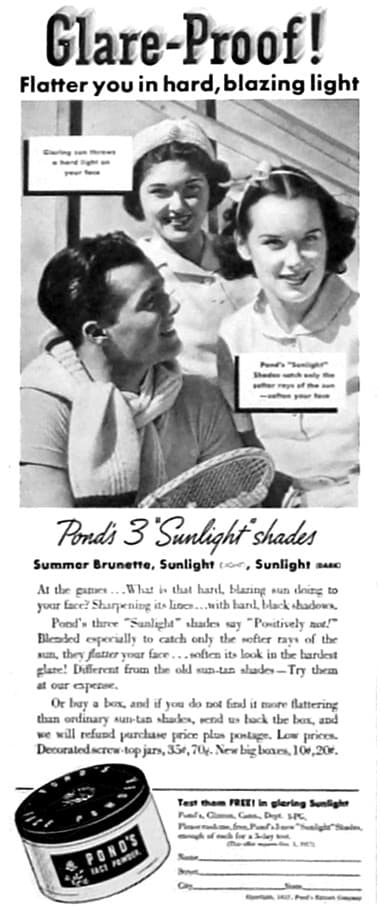
1937 Pond’s Face Powder.

1938 Pond’s products (France).
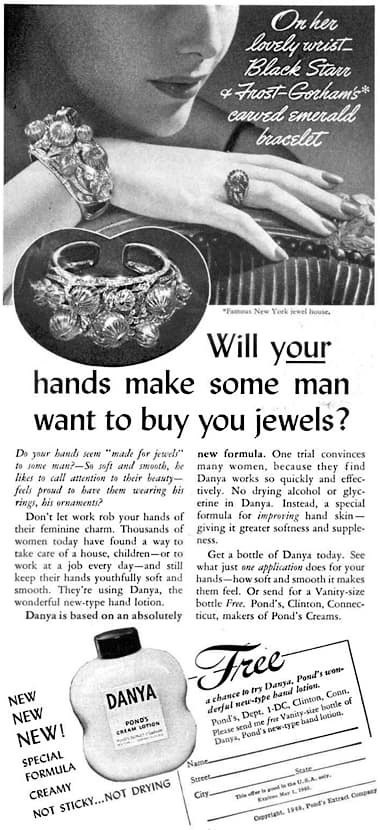
1940 Pond’s Danya.

1941 Pond’s Cold Cream and Face Powder. Pond’s often used this ‘Buy This. Get This Free’ method to get its customers to try a new product.
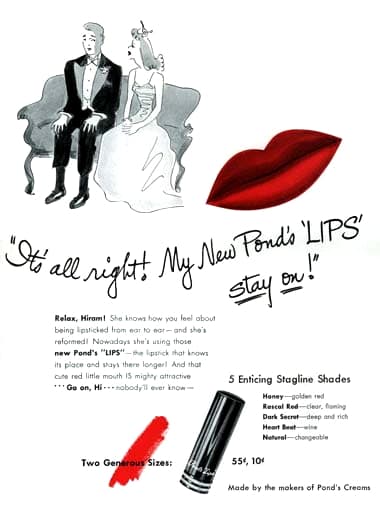
1941 Pond’s Lips lipstick.
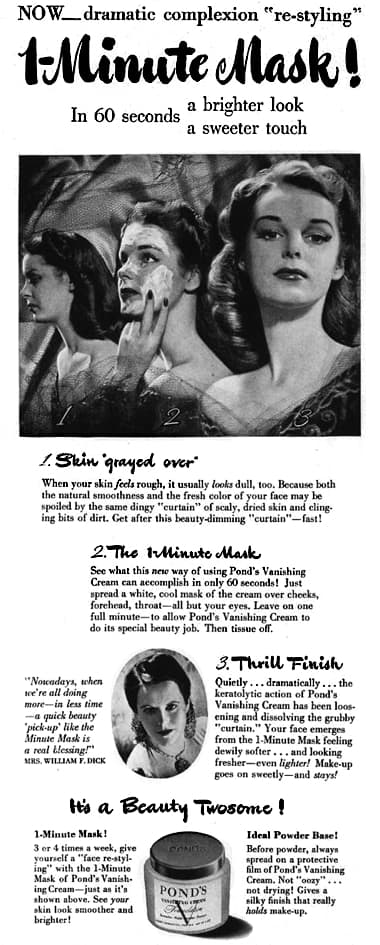
1942 Pond’s 1-Minute Mask.
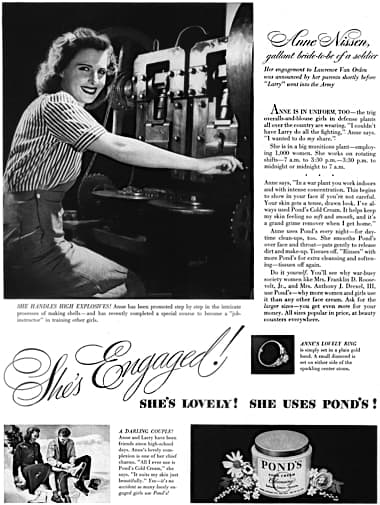
1943 Pond’s ‘She’s Engaged, She’s Lovely, She uses Pond’s’ campaign.
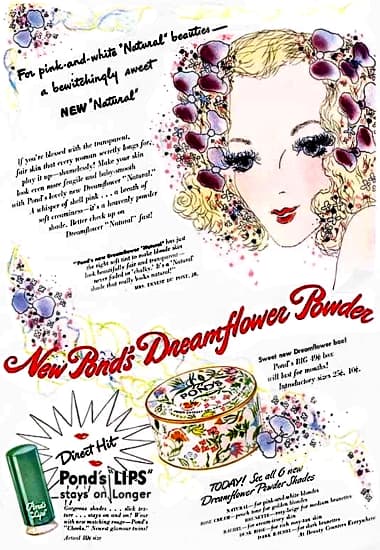
1943 Pond’s Dreamflower Powder and Lips lipstick. The Dreamflower pattern was adapted from a rare old brocade. The lipstick case with green cap and ivory base and lettering was introduced in 1942.
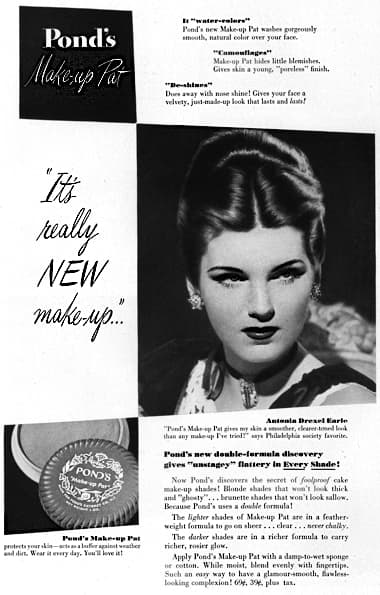
1945 Pond’s Make-up Pat.

1946 Pond’s Make-up Pat.
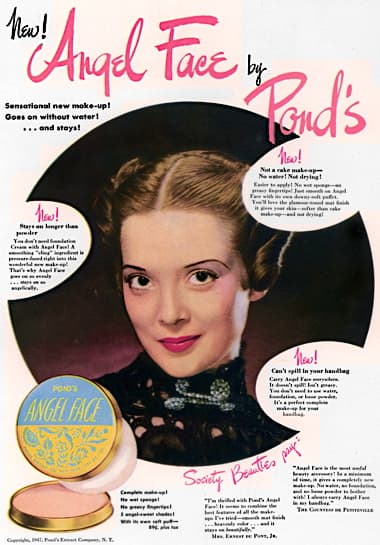
1947 Pond’s Angel Face.

1953 Pond’s Angel Face.
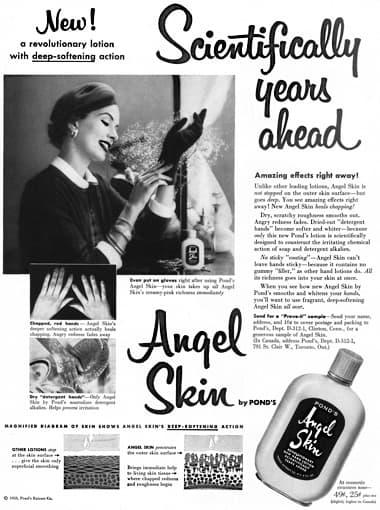
1953 Pond’s Angel Skin Hand Lotion.
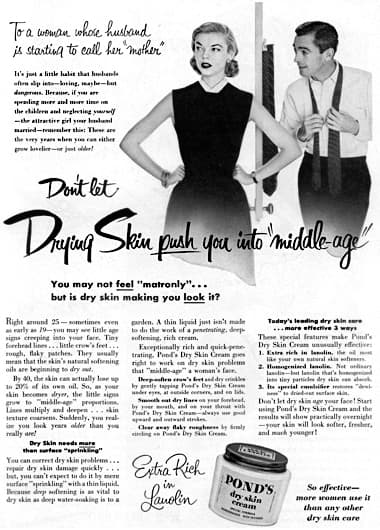
1955 Pond’s Dry Skin Cream with lanolin.

1955 Pond’s Lips Courtin’ Red shade.
